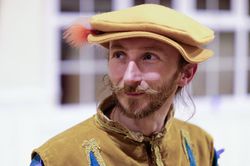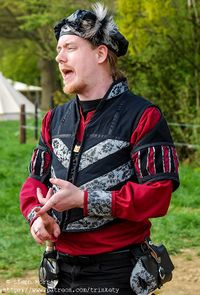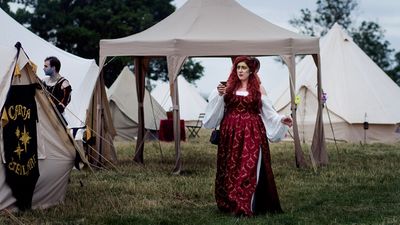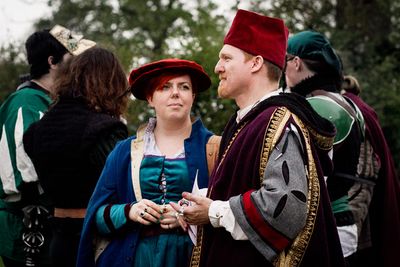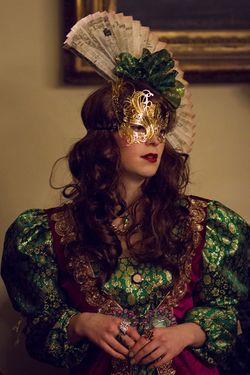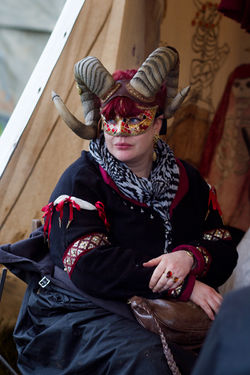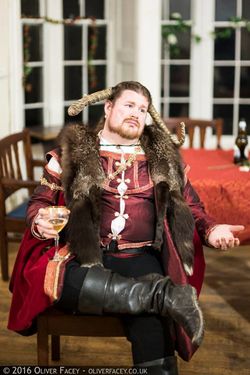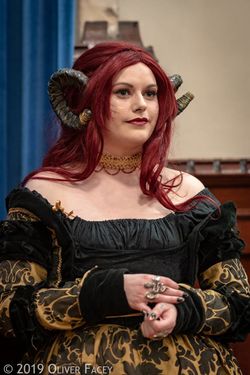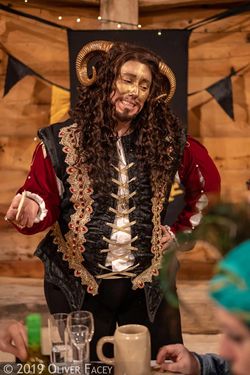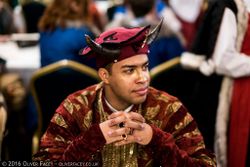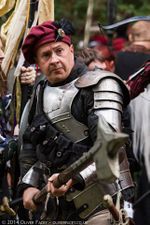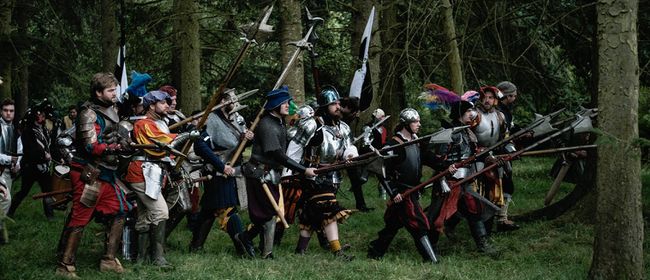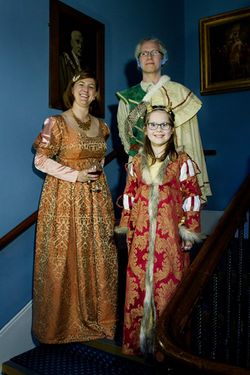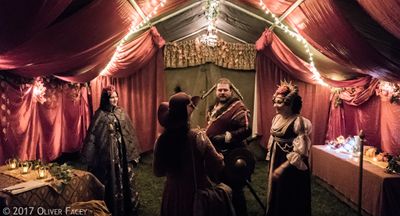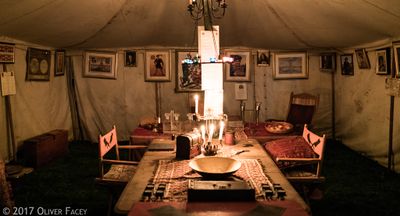Draft:The League look and feel
No edit summary |
No edit summary |
||
| (22 intermediate revisions by 3 users not shown) | |||
| Line 1: | Line 1: | ||
{{Stub}} | {{Stub}} | ||
=Overview= | ==Overview== | ||
The League is urban. | |||
<big>'''Flamboyant, rich, urbane, ambitious, loyal, resplendent, flourish.'''</big> | |||
The League is urban. Influences come from the Italian city states, the Hanseatic league, and Prague, as well as classic fantasy cities. This is a nation ruled by powerful guilds, and while there are poor people the cities are well maintained, not a shambolic chaos. | |||
The League is rich, and citizens try to display their wealth in what they wear. It is opulent but not ostentatious, a purposeful show of wealth and power. | The League is rich, and citizens try to display their wealth in what they wear. It is opulent but not ostentatious, a purposeful show of wealth and power. | ||
Costume focuses on the top half, with fitted doublets or high-waisted dresses partnered with full sleeves and tight trousers. Fussy and ornamental, league clothing uses slashes and tied on items to show off colour and fabric. | Costume focuses on the top half, with fitted doublets or high-waisted dresses partnered with full sleeves and tight trousers. Fussy and ornamental, league clothing uses slashes and tied on items to show off colour and fabric. | ||
== | League costume should reflect a city lifestyle, avoiding farming or agricultural costume. Clothes tend to be designed without regard for physical labour. | ||
Costume should say something about the character, reflecting their status, wealth, and aspirations in what they wear. Clothing is a popular topic of conversation and can be used to influence perceptions of characters. In general, leaguish citizens try to make things look more expensive than they are. | |||
==Garments and Accessories== | |||
{{CaptionedImage|file=MaesterNiccolo.jpg|width=250|align=right}} | |||
'''Hat''': While not ubiquitous, Hats are popular in the league. League Hats tend to be for show rather than practicality. Floppy cloth berets and early-tudor style bonnet hats are popular. Small caps over the hair are a good way to keep hair out of the face and show off small amounts of fancy trim and fabric, while Net snoods are popular with long hair. For costume on a budget, a floppy cloth beret is a great way to make a shirt and leggings into an iconically leaguish look. | |||
= | '''Full Shirt''': A light undershirt or chemise is the ideal baselayer. These can have a low neckline, and are often designed to complement the neckline of a doublet or gown. Off the shelf shirts in large sizes can be effective, and ideal chemises can be also be found to buy off the shelf. A modern peasant shirt might also work. Turned down collars are to be avoided if possible, as they tend to look too modern when worn with a doublet. | ||
'''Tight Trousers''' Joined hose are the historical option, and modern thick leggings or tight trousers will also work. For the modern options, covering visible belt loops or an elasticated waist will improve the look. The trousers should fit in with the rest of the outfit, but tend not to be a focal point. {{CaptionedImage|file=Emilio di Sarvos.jpg |width=200|align=left}} | |||
'''Doublet''': Doublets tend to stop at the natural waist, or have gathered skirts. The ideal waistline is straight, not pointed at the front. While there is a fashion for low necklines, high ones are also seen. Sleeves on doublets tend to be heavily slashed or segmented to show the undershirt or lining, and are often tied or laced in at the shoulders. Multiple layers of doublets are sometimes worn for warmth. | |||
'''Dress''': Gowns are tight bodiced, and tend to be high waisted, with waistlines fashionably worn under the bust, and almost never below the natural waist. A range of necklines are fashionable, from plain round ones, to square ones, to a deep V. Skirts are gathered or pleated into waistlines. Waistlines are usually straight, rather than pointed at the front. As with doublets, sleeves on gowns are often slashed or segmented to show the layer underneath. | |||
== | {{CaptionedImage|file=Nessetta Constanta.jpeg|width=400|align=right}}'''Coat or Cloak''': Coats and over-gowns tend to be loose and flowing, with turned down collars. They are often worn open or unbelted where possible to show off the clothes below. They tend to fall from the shoulders, with tied in sleeves and false sleeves being popular. Cloaks of all kinds are popular for keeping off the weather, and often have decorative linings. Single shoulder or duellists capes are popular, more for fashion than warmth, as they are an effective way of showing off beautiful fabrics. | ||
'''Rings''': Rings are very important in the League, representing loyalty and allegiances. Even if a character is not wearing any other jewellery, not wearing rings would be notable. They can be worn round the neck on a chain or ribbon as well as on the fingers. | |||
'''Mask''': Masks are a common element of fashionable attire for individuals from all walks of life. Masks allow an individual to cultivate anonymity and the air of mystery. Some groups – military units and criminals especially – may go so far as to all wear matching masks even in dangerous situations. Masks can be made of any material, from papier mache through to lace and even mirrored glass. The most common style is a half-mask covering the upper face. | |||
{{CaptionedImage|file=Chilly League Priests.jpg|width=400}} {{CaptionedImage|file=BrokenMirror.jpg|width=250}} {{CaptionedImage|file=Masked Cambion.jpg|width=250}} {{CaptionedImage|file=Relaxed Cesare.jpg |width=250}} {{CaptionedImage|file=Cambion Plotting.jpg|width=250}} {{CaptionedImage|file=Dashing Cambion.jpg|width=250}} {{CaptionedImage|file=Bishop Oberon.jpg|width=250}} | |||
==Colours and Materials== | |||
'''Base Colours:''' League clothing uses most colours, and often uses multiple colours in the same garment. Groups in the league rarely have official unified colour schemes, with the exception of the free companies. The fashions in colour differ in each city, but overall natural colours are less popular than bright ones, with clothes often designed to stand out. | |||
'''Luxurious Fabrics:''' Stronger fabrics are used for the upper layers. While fine linen, wool, and cotton are popular choices, wool in particular being very effective in slashed garments, the league likes to show off with luxury fabric, and rich looking fabrics are often used. Silks, brocade, and velvet are all popular. | |||
'''Base layers:''' Undershirts and chemises can be the exception to brightness, as they are as often left white or natural coloured as they are brightly dyed. This contrast can be used to highlight the brightness of the upper layers. Muslins, fine cotton lawn, or thin linen are ideal fabrics for this layer, and have the benefit of being comfortable to wear. | |||
==Cities== | ==Cities== | ||
With such a wide geographical range, different fashions thrive in each league city | With such a wide geographical range, different fashions thrive in each league city. | ||
===Sarvos | ===Sarvos=== | ||
Sarvos, sitting almost on the water, is the most southern of the cities. Here, doublets and gowns tend to be made out of lighter fabrics, and the look is heavily inspired by Italian city states. The colours tend to be bright and light colours; pale golds, turquoise, delicate greens, blues, and pinks are all fashionable. Doublets and Gown bodices tend to be small, with very low necklines, and doublets are less likely to have skirts than in the northern cities. | |||
===Tassato=== | |||
Like Sarvos, Tassato fashions are for lighter fabrics and smaller bodices and doublets. However, the colours used are bolder; bright colours are common, but fewer lighter ones; strong gold; royal blue and purple, bright reds, dark pinks. Duels are more popular in Tassato than any other of the cities, and fashion tends to reflect that, with split skirts popular, and short duelling capes. | |||
===Holberg=== | ===Holberg=== | ||
Known for its’ walls and fortifications, Holberg fashion tends towards structure and heavy fabrics. The overall look is solid and secure. Colours tend to be dark and rich, and heavy fabrics are used. Skirted doublets are more popular than in the southern cities, and more inspiration can be drawn from Northern European and Landsknecht fashion. With it’s years of war, leather garments tend to be more popular in Holberg than other cities. | Known for its’ walls and fortifications, Holberg fashion tends towards structure and heavy fabrics. The overall look is solid and secure. Colours tend to be dark and rich, though black is still less common, and heavy fabrics are used. Skirted doublets are more popular than in the southern cities, and more inspiration can be drawn from Northern European and Landsknecht fashion. With it’s years of war, leather garments tend to be more popular in Holberg than the other cities. | ||
===Temeschwar=== | ===Temeschwar=== | ||
Further north, Temeschwar fashions have a focus on warmth. Heavy fabrics and furs are paramount, and they use similar rich colours to Holberg. | Further north, Temeschwar fashions have a focus on warmth. Heavy fabrics and furs are paramount, and they use similar rich colours to Holberg. The Varushkan heritage of the city has led to trends of offsetting very dark colours with contrasting bright ones. Robes and coats are more popular in this northern city than in the southern ones. | ||
==Battle== | |||
{{CaptionedImage|file=HolbergDefender.jpg|width=150|align=right}} | |||
'''Armour:''' Brigandines, Arming Doublets, and Padded Jacks are common, as are sections of plate, though a full harness is unlikely to be seen. Chain is often worn covered with leather or cloth doublets. | |||
'''Weapons:''' Professional soldiers tend to prefer long spears, halberds, and other polearms. Street fighters usually favour a light sword with a main gauche or stiletto (a small dagger) for the off-hand. Shields are not common in either case. | |||
Crossbows are the most commonly used ranged weapon, including among members of free companies. | |||
{{CaptionedImage|file=ForwardFreeCompany.jpg|width=650}} | |||
'''Bravos:''' Bravos tend to be lightly armoured, and a single substantial shoulder piece is a popular addition. | |||
'''Free Companies:''' Free companies often try to have a unifying feature in their clothing, whether sashes, matching padded jack, or total colour scheme. However, this is not a uniform, and few Companies will have a totally uniform look. Individuality is a source of pride. As mercenaries, most free companies will supply their members with armour and a weapon, though often the armour is simply a padded jack and helmet. The use of sashes to denote serving members of the militia started in Temeschwar, inspired by Free Company sashes. A distinctive banner is a popular item for most free companies, as it serves as both a rallying point in battle and an advertisement of their skills. | |||
== | ==Religion== | ||
The heavily decorated robes of The League priests are in sharp contrast to some of the ascetics of other nations. Lavish embroidery, metallic threads and elaborate headdresses are all popular in communicating their importance. | |||
==Magic== | |||
== | A troupe of magicians can be like family, and while they rarely wear anything that could be seen as a uniform some troupes will attempt to create similar styles with their clothing. | ||
Mountebanks tend to be attempting more of a show in the immediate moment, often trying to look ostentatious or eye-catching, and they have a tendency to play with appearance. A mountebank’s style is sometimes used as a code for looking a little gauche. | |||
While most citizens of the league will make use of masks, it is magicians who rely on them the most. Dramaturgy is very common, and League troops will jealously protect their masks. | |||
= | =Children= | ||
Children of guild members are a chance to show off the future of the guild, and their parent's success. However, everyone knows that children grow quickly, and children's clothes are often simpler than adults. While few will admit to it, children's clothes are often made from leftover or offcuts of fabric. | |||
{{CaptionedImage|file=Young_Printers_Guild.jpg|width=250}} | |||
= | =Camps= | ||
Even in the field, Leaguish citizens try to put on a show. Guilds and Free Companies often organise camping around a main tent or pavillion, which is decorated and used as a space of hospitality and business. Particular efforts are made to separate sleeping areas from these more public spaces, either by putting them in separate tents, or by dividing the tent. | |||
==Tent Decoration== | |||
While a guild's tent may be plain white canvas outside, inside it may look very different. Elaborate lighting designs and hanging drapes can be used to create a luxurious space, and folding tables and furniture are often covered with cloths and cushions. Some guilds, Camorras, and free companies will decorate their space with paintings and drawings of members, particularly deceased or notorious ones, and many also bring mirrors into the space- an important part of league hearth magic. | |||
{{CaptionedImage|file=League_Theatre.jpg|width=400}} {{CaptionedImage|file=The_Bloody_Tent.jpg|width=400}} | |||
==Outside The Brief== | |||
To define the ideal look and feel for The League we have deliberately chosen to exclude some themes. This is important because it helps to create a clear visual aesthetic for the nation. The goal is to make members of the nation visually distinct from the other nations in play and to ensure that the costume guidelines don't become diluted by including ideas for costume from similar sources. We explicitly define some costume ideas and inspirations as not part of the brief for The League to make what definitely ''does'' fit the brief clearer and more distinct. | |||
Most things that are not part of a nation's brief are considered to be ''less appropriate'' as they are not not strictly part of the costume brief. This means that you can still use them if you need to but they are not something that you should actively aim for when you are creating or buying something for your Leaguish character. Creating a costume is always a compromise as time and money are limited, so it is sensible to use a garment or prop that is ''less appropriate'' if you already own it, if that allows you to focus on improving other parts of your costume. | |||
A few things are explicitly defined as ''inappropriate''. These are things that you should not use when you are in-character at an event, because of the real-world connotations or imagery associated with them. We have deliberately omitted these elements because they are so striking and memorable that it is impossible to see them without thinking of the themes associated with them. | |||
A | |||
=Similar Nations= | ==Similar Nations== | ||
Leaguish and Dawnish fashions both feature gowns and doublets, however, Leaugish tailoring tends to be more fussy, with slashes, ribbons, and flounces. League gowns are much higher waisted than Dawnish ones, as are league doublets. | Leaguish and Dawnish fashions both feature gowns and doublets, however, Leaugish tailoring tends to be more fussy, with slashes, ribbons, and flounces. League gowns are generally much higher waisted than Dawnish ones, as are league doublets. For gowns in particular, gathering or pleating the skirt into the waistline will make a distinctively League gown. | ||
There is some similarity in garments worn in the | There is some similarity in garments worn in the Marches, however, leaguish clothing is more likely to feature extensive decoration and less practical colours and fabrics. | ||
There is some overlap between | There is some overlap between Temeschwar and Varushka. However, Varushkan wide trousers are rarely seen in the city, and Varushkan clothes rarely feature silks, velvet, or brocade. | ||
= | ==Less Appropriate== | ||
Elizabethan and Late Tudor looks | Elizabethan and Late Tudor looks. These can look too modern and jarring in the context of Empire. These looks include: | ||
*Padded clothes- Slashes are popular, but try not to pad them out | *Padded clothes- Slashes are popular, but try not to pad them out | ||
*Low or pointed waistlines- keep waistlines straight and high where possible. | *Low or pointed waistlines- keep waistlines straight and high where possible. | ||
*Wide trousers or Breeches | *Wide trousers or Breeches | ||
*Conical or Straight bodices and corsets- the shape of the body is much more natural than overbust corsets create. | *Conical or Straight bodices and corsets- the shape of the body is much more natural than overbust corsets create. | ||
*Hoop skirts and Bustles. The skirts should fall naturally from the waistline of dresses, with any volume coming from pleats of fabric. | *Hoop skirts and Bustles. The skirts should fall naturally from the waistline of dresses, with any volume coming from pleats of fabric or a petticoat underneath. | ||
*High standing collars and wide collared shirts | |||
Dandies- The typical makeup and dress of the European Dandy comes from the 18th century so is far more modern than the ideal league aesthetic. | Dandies- The typical makeup and dress of the European Dandy comes from the 18th century so is far more modern than the ideal league aesthetic. | ||
Wench Costumes | Wench Costumes, or corsets worn as bodices. | ||
Latest revision as of 20:43, 11 November 2021
Overview
Flamboyant, rich, urbane, ambitious, loyal, resplendent, flourish.
The League is urban. Influences come from the Italian city states, the Hanseatic league, and Prague, as well as classic fantasy cities. This is a nation ruled by powerful guilds, and while there are poor people the cities are well maintained, not a shambolic chaos. The League is rich, and citizens try to display their wealth in what they wear. It is opulent but not ostentatious, a purposeful show of wealth and power. Costume focuses on the top half, with fitted doublets or high-waisted dresses partnered with full sleeves and tight trousers. Fussy and ornamental, league clothing uses slashes and tied on items to show off colour and fabric.
League costume should reflect a city lifestyle, avoiding farming or agricultural costume. Clothes tend to be designed without regard for physical labour.
Costume should say something about the character, reflecting their status, wealth, and aspirations in what they wear. Clothing is a popular topic of conversation and can be used to influence perceptions of characters. In general, leaguish citizens try to make things look more expensive than they are.
Garments and Accessories
Hat: While not ubiquitous, Hats are popular in the league. League Hats tend to be for show rather than practicality. Floppy cloth berets and early-tudor style bonnet hats are popular. Small caps over the hair are a good way to keep hair out of the face and show off small amounts of fancy trim and fabric, while Net snoods are popular with long hair. For costume on a budget, a floppy cloth beret is a great way to make a shirt and leggings into an iconically leaguish look.
Full Shirt: A light undershirt or chemise is the ideal baselayer. These can have a low neckline, and are often designed to complement the neckline of a doublet or gown. Off the shelf shirts in large sizes can be effective, and ideal chemises can be also be found to buy off the shelf. A modern peasant shirt might also work. Turned down collars are to be avoided if possible, as they tend to look too modern when worn with a doublet.
Tight Trousers Joined hose are the historical option, and modern thick leggings or tight trousers will also work. For the modern options, covering visible belt loops or an elasticated waist will improve the look. The trousers should fit in with the rest of the outfit, but tend not to be a focal point.
Doublet: Doublets tend to stop at the natural waist, or have gathered skirts. The ideal waistline is straight, not pointed at the front. While there is a fashion for low necklines, high ones are also seen. Sleeves on doublets tend to be heavily slashed or segmented to show the undershirt or lining, and are often tied or laced in at the shoulders. Multiple layers of doublets are sometimes worn for warmth.
Dress: Gowns are tight bodiced, and tend to be high waisted, with waistlines fashionably worn under the bust, and almost never below the natural waist. A range of necklines are fashionable, from plain round ones, to square ones, to a deep V. Skirts are gathered or pleated into waistlines. Waistlines are usually straight, rather than pointed at the front. As with doublets, sleeves on gowns are often slashed or segmented to show the layer underneath.
Coat or Cloak: Coats and over-gowns tend to be loose and flowing, with turned down collars. They are often worn open or unbelted where possible to show off the clothes below. They tend to fall from the shoulders, with tied in sleeves and false sleeves being popular. Cloaks of all kinds are popular for keeping off the weather, and often have decorative linings. Single shoulder or duellists capes are popular, more for fashion than warmth, as they are an effective way of showing off beautiful fabrics.
Rings: Rings are very important in the League, representing loyalty and allegiances. Even if a character is not wearing any other jewellery, not wearing rings would be notable. They can be worn round the neck on a chain or ribbon as well as on the fingers.
Mask: Masks are a common element of fashionable attire for individuals from all walks of life. Masks allow an individual to cultivate anonymity and the air of mystery. Some groups – military units and criminals especially – may go so far as to all wear matching masks even in dangerous situations. Masks can be made of any material, from papier mache through to lace and even mirrored glass. The most common style is a half-mask covering the upper face.
Colours and Materials
Base Colours: League clothing uses most colours, and often uses multiple colours in the same garment. Groups in the league rarely have official unified colour schemes, with the exception of the free companies. The fashions in colour differ in each city, but overall natural colours are less popular than bright ones, with clothes often designed to stand out.
Luxurious Fabrics: Stronger fabrics are used for the upper layers. While fine linen, wool, and cotton are popular choices, wool in particular being very effective in slashed garments, the league likes to show off with luxury fabric, and rich looking fabrics are often used. Silks, brocade, and velvet are all popular.
Base layers: Undershirts and chemises can be the exception to brightness, as they are as often left white or natural coloured as they are brightly dyed. This contrast can be used to highlight the brightness of the upper layers. Muslins, fine cotton lawn, or thin linen are ideal fabrics for this layer, and have the benefit of being comfortable to wear.
Cities
With such a wide geographical range, different fashions thrive in each league city.
Sarvos
Sarvos, sitting almost on the water, is the most southern of the cities. Here, doublets and gowns tend to be made out of lighter fabrics, and the look is heavily inspired by Italian city states. The colours tend to be bright and light colours; pale golds, turquoise, delicate greens, blues, and pinks are all fashionable. Doublets and Gown bodices tend to be small, with very low necklines, and doublets are less likely to have skirts than in the northern cities.
Tassato
Like Sarvos, Tassato fashions are for lighter fabrics and smaller bodices and doublets. However, the colours used are bolder; bright colours are common, but fewer lighter ones; strong gold; royal blue and purple, bright reds, dark pinks. Duels are more popular in Tassato than any other of the cities, and fashion tends to reflect that, with split skirts popular, and short duelling capes.
Holberg
Known for its’ walls and fortifications, Holberg fashion tends towards structure and heavy fabrics. The overall look is solid and secure. Colours tend to be dark and rich, though black is still less common, and heavy fabrics are used. Skirted doublets are more popular than in the southern cities, and more inspiration can be drawn from Northern European and Landsknecht fashion. With it’s years of war, leather garments tend to be more popular in Holberg than the other cities.
Temeschwar
Further north, Temeschwar fashions have a focus on warmth. Heavy fabrics and furs are paramount, and they use similar rich colours to Holberg. The Varushkan heritage of the city has led to trends of offsetting very dark colours with contrasting bright ones. Robes and coats are more popular in this northern city than in the southern ones.
Battle
Armour: Brigandines, Arming Doublets, and Padded Jacks are common, as are sections of plate, though a full harness is unlikely to be seen. Chain is often worn covered with leather or cloth doublets.
Weapons: Professional soldiers tend to prefer long spears, halberds, and other polearms. Street fighters usually favour a light sword with a main gauche or stiletto (a small dagger) for the off-hand. Shields are not common in either case. Crossbows are the most commonly used ranged weapon, including among members of free companies.
Bravos: Bravos tend to be lightly armoured, and a single substantial shoulder piece is a popular addition.
Free Companies: Free companies often try to have a unifying feature in their clothing, whether sashes, matching padded jack, or total colour scheme. However, this is not a uniform, and few Companies will have a totally uniform look. Individuality is a source of pride. As mercenaries, most free companies will supply their members with armour and a weapon, though often the armour is simply a padded jack and helmet. The use of sashes to denote serving members of the militia started in Temeschwar, inspired by Free Company sashes. A distinctive banner is a popular item for most free companies, as it serves as both a rallying point in battle and an advertisement of their skills.
Religion
The heavily decorated robes of The League priests are in sharp contrast to some of the ascetics of other nations. Lavish embroidery, metallic threads and elaborate headdresses are all popular in communicating their importance.
Magic
A troupe of magicians can be like family, and while they rarely wear anything that could be seen as a uniform some troupes will attempt to create similar styles with their clothing.
Mountebanks tend to be attempting more of a show in the immediate moment, often trying to look ostentatious or eye-catching, and they have a tendency to play with appearance. A mountebank’s style is sometimes used as a code for looking a little gauche.
While most citizens of the league will make use of masks, it is magicians who rely on them the most. Dramaturgy is very common, and League troops will jealously protect their masks.
Children
Children of guild members are a chance to show off the future of the guild, and their parent's success. However, everyone knows that children grow quickly, and children's clothes are often simpler than adults. While few will admit to it, children's clothes are often made from leftover or offcuts of fabric.
Camps
Even in the field, Leaguish citizens try to put on a show. Guilds and Free Companies often organise camping around a main tent or pavillion, which is decorated and used as a space of hospitality and business. Particular efforts are made to separate sleeping areas from these more public spaces, either by putting them in separate tents, or by dividing the tent.
Tent Decoration
While a guild's tent may be plain white canvas outside, inside it may look very different. Elaborate lighting designs and hanging drapes can be used to create a luxurious space, and folding tables and furniture are often covered with cloths and cushions. Some guilds, Camorras, and free companies will decorate their space with paintings and drawings of members, particularly deceased or notorious ones, and many also bring mirrors into the space- an important part of league hearth magic.
Outside The Brief
To define the ideal look and feel for The League we have deliberately chosen to exclude some themes. This is important because it helps to create a clear visual aesthetic for the nation. The goal is to make members of the nation visually distinct from the other nations in play and to ensure that the costume guidelines don't become diluted by including ideas for costume from similar sources. We explicitly define some costume ideas and inspirations as not part of the brief for The League to make what definitely does fit the brief clearer and more distinct.
Most things that are not part of a nation's brief are considered to be less appropriate as they are not not strictly part of the costume brief. This means that you can still use them if you need to but they are not something that you should actively aim for when you are creating or buying something for your Leaguish character. Creating a costume is always a compromise as time and money are limited, so it is sensible to use a garment or prop that is less appropriate if you already own it, if that allows you to focus on improving other parts of your costume.
A few things are explicitly defined as inappropriate. These are things that you should not use when you are in-character at an event, because of the real-world connotations or imagery associated with them. We have deliberately omitted these elements because they are so striking and memorable that it is impossible to see them without thinking of the themes associated with them.
Similar Nations
Leaguish and Dawnish fashions both feature gowns and doublets, however, Leaugish tailoring tends to be more fussy, with slashes, ribbons, and flounces. League gowns are generally much higher waisted than Dawnish ones, as are league doublets. For gowns in particular, gathering or pleating the skirt into the waistline will make a distinctively League gown.
There is some similarity in garments worn in the Marches, however, leaguish clothing is more likely to feature extensive decoration and less practical colours and fabrics.
There is some overlap between Temeschwar and Varushka. However, Varushkan wide trousers are rarely seen in the city, and Varushkan clothes rarely feature silks, velvet, or brocade.
Less Appropriate
Elizabethan and Late Tudor looks. These can look too modern and jarring in the context of Empire. These looks include:
- Padded clothes- Slashes are popular, but try not to pad them out
- Low or pointed waistlines- keep waistlines straight and high where possible.
- Wide trousers or Breeches
- Conical or Straight bodices and corsets- the shape of the body is much more natural than overbust corsets create.
- Hoop skirts and Bustles. The skirts should fall naturally from the waistline of dresses, with any volume coming from pleats of fabric or a petticoat underneath.
- High standing collars and wide collared shirts
Dandies- The typical makeup and dress of the European Dandy comes from the 18th century so is far more modern than the ideal league aesthetic.
Wench Costumes, or corsets worn as bodices.
